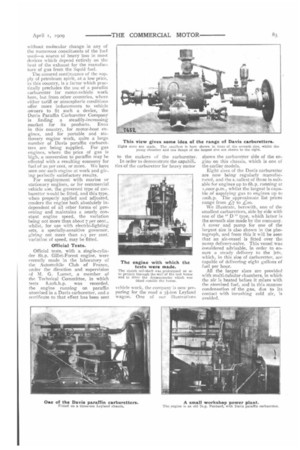Experiments with a Paraffin Carburetter.
Page 16

Page 17

If you've noticed an error in this article please click here to report it so we can fix it.
The action of the precision-feed carburetter which is made by the Davis Paraffin Carburetter Company, of Station Avenue, Kew Gardens, Surrey, was described in our issue of the 9th April last, and the favourable impression which we had then formed in regard to this invention has been fully justified by the work that has been performed by carburetters of the type, and by the progress that has attended the operations of the makers during the past year. Mr. Davis has frequently received enquiries from interested parties who wished for definite information upon the behaviour of his carburetters when used for the atomisation of some particular grade of petroleum, or other form of liquid fuel, and, not being in a position to give a satisfactory reply in every ease, he determined to make a series of comparative tests on a new engine.
For the purpose of his experiments, Mr. Davis selected a two-cylinder, water-cooled Blake engine the cylinders of which are to5mm. in diameter, and the piston-stroke 120111M. in length. The compression pressure within the cylinders was 751b. per square inch, and the engine, as tested by its maker, with a Prony brake, developed to4h.p., when running on Pratt's spirit (specific gravity .715) atomised in a model " B34 " Longue. mare carburetter. This engine was direct coupled to one of Walker's water dynamometers, and, in place of the Longuemare carburetter, a model " B " Davis paraffin carburetter was fitted. A series of one-hour full-load tests was then made, with different
kinds of fuel, and the results of these tests are set out in the accompanying table.
It will be seen, that, when the engine was running on American White Rose petroleum, the horse-power developed was slightly in excess of that obtained from the lighter fuel with which the engine-maker's test run was made, although in every other case the power showed a slight decrease. The loss of power, however, was not nearly so great as would have been the case had any form of" vaporiser " been employed. The measured mechanical feed for the fuel in this device gives a certainty of action which is not obtainable in a vaporiser, whilst the combination of the precision feed with the mechanical atomisation of the fuel yields a rich firing mixture without molecular change in any of the numerous constituents of the fuel used—a source of heavy loss in most devices which depend entirely on the heat of the exhaust for the manufacture of gas from the liquid fuel.
The assured continuance of the supply of petroleum spirit, at a low price, in this country, is a factor which practically precludes the use of a paraffin carburetter for motor-vehicle work here, but from other countries, where either tariff or atmospheric conditions offer more inducements to vehicle owners to fit such a device, the Davis Paraffin Carburetter Company is finding a steadily-increasing market for its products. Even in this country, for motor-boat engines, and for portable and stationary engine work, quite a large number of Davis paraffin carburetters are being supplied. For gas engines, where the price of gas is high, a conversion to paraffin may be effected with a resulting economy for fuel of 20 per cent, or more. We have seen one such engine at work and givingperfectly satisfactory results.
For employment with marine or stationary engines, or for commercial vehicle use, the governed type of carburetter would be fitted, and this type, when properly applied and adjusted, renders the engine both absolutely independent of all other forms of governing and maintains a nearly constant engine speed, the variation being not more than about 7 per cent., whilst, for use with electric-lighting sets, a specially-sensitive governor, givingnot more than 2-3 per cent. variation of speed, may be fitted.
Official Tests.
Official tests, with a single-cylinder Shp. Gillet-Forest engine, were recently made in the laboratory of the Automobile Club of France, under the direction and supervision of M. G. Lumet, a member of the Technical Committee, in which tests 8.o2b.h.p. was recorded, the engine running on paraffin atomised in a Davis carburetter, and a certificate to that effect has been sent to the makers of the carburetter. In order to demonstrate the capabilities of the carburetter for heavy motor vehicle work, the company is now preparing for the road a 34-ton Leyland wagon. One of our illustrations shows the carburetter side of the engine on this chassis, which is one of the earlier models.
Eight sizes of the Davis carburetter are now being regularly manufactured, and the s.nallest of these is suitable for engines up to 6h.p. running at 1,000r.p.m., whilst the largest is capable of supplying gas to engines up to tooh.p. The approximate list prices range from j to We illustrate, herewith, one of the smallest carburetters, side by side with one of the " D" type, which latter is the seventh size made by the company. A cover and pump for one of the largest size is also shown in the photograph, and from this it will be seen that an air-vessel is fitted over the pump delivery-valve. This vessel was considered advisable, in order to ensure a steady delivery to the jets, which, in this size of carburetter, are capable of delivering eight gallons of fuel per hour.
All the larger sizes are provided with multi-tubular chambers, in which the air is heated before it mixes with the atomised fuel, and in this manner condensation of the gas, due to its contact with inrushing cold air, is avoided.






















